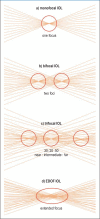Cataract Surgery-Indications, Techniques, and Intraocular Lens Selection
- PMID: 36794457
- PMCID: PMC10413970
- DOI: 10.3238/arztebl.m2023.0028
Cataract Surgery-Indications, Techniques, and Intraocular Lens Selection
Abstract
Background: Opacification of the lens of the eye (cataract) is usually due to aging. It is a painless, progressive condition that affects contrast and color perception and alters refraction, leading to visual loss that may be total. In cataract surgery, the turbid lens is replaced by an artificial lens. An estimated 600 000 to 800 000 such procedures are performed in Germany each year.
Methods: This review is based on pertinent publications retrieved by a selective search in PubMed, including meta-analyses, Cochrane reviews, and randomized controlled clinical trials (RCTs).
Results: Cataract is the most common reversible cause of blindness around the world (approximately 95 million people). The surgical replacement of a turbid lens with an artificial lens is usually carried out under local anesthesia. The standard technique for fragmentation of the nucleus of the lens is ultrasonic phacoemulsification. RCTs have not shown the superiority of the femtosecond laser over phacoemulsification for this purpose so far. The spectrum of artificial intraocular lenses, aside from the conventional type with a single focus, include lenses with multiple foci, extended-depth-of-focus (EDOF) lenses, and astigmatism-correcting lenses.
Conclusion: In Germany, cataract surgery is usually performed on an outpatient basis under local anesthesia. Artificial lenses with various additional functions are available nowadays; the choice of lens depends on the needs of the individual patient. Patients must be adequately informed about the advantages and disadvantages of the different lens systems.
Figures



References
-
- Liu YC, Wilkins M, Kim T, Malyugin B, Mehta JS. Cataracts. Lancet. 2017;390:600–612. - PubMed
-
- GBD 2019 Blindness and Vision Impairment Collaborators, Vision Loss Expert Group of the Global Burden of Disease Study. Trends in prevalence of blindness and distance and near vision impairment over 30 years: an analysis for the Global Burden of Disease Study. Lancet Glob Health. 2021;9:e130–e143. - PMC - PubMed
-
- Klein BE, Klein R, Lee KE. Incidence of age-related cataract: the beaver dam eye study. Arch Ophthalmol. 1998;116:219–225. - PubMed
-
- Lagrèze WA. Treatment of congenital and early childhood cataract. Ophthalmol Z Dtsch Ophthalmol Ges. 2021;118:135–144. - PubMed
Publication types
MeSH terms
LinkOut - more resources
Full Text Sources
Medical

